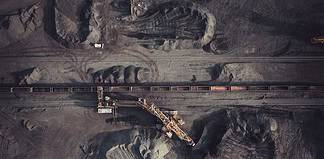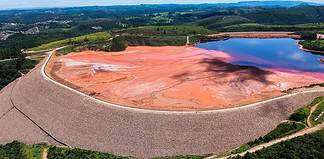 THE mineral sands industry consists of two core product streams: titanium minerals (also referred to as titanium dioxide feedstocks or TiO2 feedstocks) and zircon. Titanium minerals are generally far more prevalent in mineral sand ore bodies than zircon is.
THE mineral sands industry consists of two core product streams: titanium minerals (also referred to as titanium dioxide feedstocks or TiO2 feedstocks) and zircon. Titanium minerals are generally far more prevalent in mineral sand ore bodies than zircon is.
The titanium dioxide content of various titanium minerals varies markedly, from less than 50 per cent to more than 95 per cent, and it is this that mainly determines
the value of a mineral sands deposit. Iluka Resources is the world’s major producer of zircon and a significant producer of high-grade titanium dioxide products.
One of the major products of Iluka’s Australian mineral sands operations is synthetic rutile: a beneficiated product derived from the titanium mineral ilmenite. Naturally-occurring rutile generally contains between 92 and 96 per cent titanium dioxide, while naturally-occurring ilmenite contains between 35 and 65 per cent. Synthetic rutile contains between 85 and 95 per cent.
Rutile, synthetic rutile, ilmenite and zircon have a wide range of consumer, lifestyle and industrial applications, including paint pigments, plastics, papers, titanium metal production, welding electrodes, floor and wall tiles, sanitary ware, zirconium-based chemicals and zirconia metal applications. Iluka’s overall revenue base is
balanced between four main geographical markets: about one quarter of its revenue is derived from China, other areas of Asia, the Americas and Europe respectively.
The company’s revenue base is also relatively balanced between zircon and high-grade titanium dioxide products.
According to Iluka, a number of factors suggest a favourable medium- to long-term demand for its main products: developing economy demand related to urbanisation; increased personal consumption levels; and current low intensity of use relative to developed economies for end product applications of zircon and titanium dioxide.
Jacinth-Ambrosia
Iluka’s Jacinth-Ambrosia operation is the largest, highest assemblage zircon development in the world. It had a production rate of about 300,000t of zircon in its first years of production and it is capable of meeting about 20 per cent of global zircon demand.
The Jacinth-Ambrosia mine comprises two contiguous deposits: Jacinth and Ambrosia. The operation lies about 800km from Adelaide in the Eucla Basin, 270km from the Port of Thevenard near the township of Ceduna.
The two deposits are mined sequentially using dry mining techniques and ore is fed to a 1400t per hour in-pit mining unit to remove oversized material.
The slurried ore is then pumped to the 1000t/h wet concentrator plant, which separates the various fractions in the ore to produce HMC.
Jacinth-Ambrosia set a record for the fastest remote resource development in Australia as it was developed and in production within five years of its discovery. The project operates on a fly-in, fly-out basis and employs about 70 people on site.
Water for the project’s processing operations is sourced from a hypersaline paleochannel and borefield 34km from the process plant. Iluka draws about 7 gigalitres of water per year from the paleochannel and has estimated it will consume about 6 per cent of the paleochannel’s entire volume in the course of Jacinth-Ambrosia’s mine life.
A reverse osmosis plant on site supplies potable water along with water for the on-site fire protection system. Site electricity is provided by a 6.8 to 9.4 megawatt diesel-powered generator built, owned and operated by Iluka. Iluka developed Jacinth-Ambrosia to be a highly capital-efficient operation: the majority of HMC produced on site is transported via road trains and ships to the company’s Narngulu mineral processing plant in WA. Since the start of this year, HMC has also been shipped to the Port of Portland in Victoria for processing at Iluka’s Hamilton plant.
WA operations
Iluka’s WA operations constitute mining and processing facilities, and a mineral separation plant near Geraldton that processes HMC from the company’s major Jacinth-Ambrosia operation in South Australia, and from mining near Geraldton and Capel in WA. Iluka also operates a dry separation plant at Capel.
In February, Iluka reported a net rise in its total Perth Basin ore reserves to 17.97 million tonnes: a 41 per cent net increase. The company also reported a 4 per cent net increase to 60.85mt in its Perth Basin mineral resource.
Eneabba
In July 2011, Iluka announced its intention to re-start mining activities at its Eneabba mine in the Perth Basin. The company committed $35 million in capital expenditure to the renewed operation, part of which related to a maintenance outage for refiring of a synthetic rutile kiln.
Mining re-started at Eneabba in December 2011, and processing began early in 2012. The operation is now producing about 140 thousand tonnes per annum of chloride ilmenite, a feedsource for the production of premium synthetic rutile, as well as 25ktpa each of zircon and rutile.
Iluka is also undertaking a feasibility study on another potential Perth Basin project, Cataby, which it has described as “significant”.
Narngulu mineral separation plant With a production capacity of 800ktpa, Iluka’s Narngulu mineral separation plant near Geraldton is the largest mineral processing facility in the world.
The plant utilises electrostatic and electromagnetic separation plus a dry milling process to produce zircon, rutile and other high-grade titanium products, and ilmenite. Finished products are exported through the Port of Geraldton, which is 9km from Narngulu.
The Narngulu facility was upgraded in 2009 and 2010 to accept Jacinth-Ambrosia HMC, and Iluka recently expanded the plant’s capacity again to allow it to also process HMC from Eneabba.
Tutunup South
Iluka completed construction and commissioning of its Tutunup South mine in WA’s South West in June 2011. The mine supplies magnetic chloride ilmenite, used as a feedsource for Iluka’s synthetic rutile operations, which is processed at the Capel dry separation plant. Some non-magnetic material production from the mine (zircon and rutile) is also processed at the Narngulu plant, depending on plant availability.
Synthetic rutile production Iluka owns four synthetic rutile kilns used to upgrade ilmenite to higher-value synthetic rutile. The kilns have a total capacity of between 500kt and 550kt, dependent on product specifications.
In recent years, Iluka has chosen to idle part of its synthetic rutile production capacity, stating that it would await appropriate market and economic conditions before reactivating upgraded capacity.
During 2010 and 2011, the company operated two of its four synthetic rutile kilns: SR2 in the South West and SR3 in the Mid West. During 2011, SR3 was also used for research and development, which included ilmenite blending and reactant input trials. It was reactivated for commercial production in October 2011, following a major maintenance outage.
Iluka has reported that SR3 is expected to produce about 120ktpa of synthetic rutile, while SR2 has a production capacity of about 200ktpa.
According to Iluka managing director David Robb, the company has increased its investment in product development in the past two years, with a specific focus on
synthetic rutile.
“Progress has been very encouraging,” Mr Robb said.
“Iluka has developed a new synthetic rutile product, SR 85, based on Murray Basin ilmenite.
“Trial work with customers is in train for a high-grade sulphate pigment feedstock, acid-soluble synthetic rutile, while a new high-value chloride pigment feedstock is also being investigated. “I view this area as a potentially significant area of value creation.”
Murray Basin operations
Victoria’s Murray Basin is Iluka’s principal source of rutile production as well as a major contributor to the company’s zircon production stream.
Its Murray Basin operations originally comprised mining and concentration activities at Douglas and Kulwin, with mining activities having begun in the Douglas region in 2004 and in the Kulwin region in 2010, and were completed in early 2012.
Mining and processing equipment from Kulwin was then relocated to the Woornack, Rownack and Pirro deposits, where mining began in May. Iluka reported that feasibility work was under way for the potential development of the large Balranald deposit, as well as associated deposits including Nepean.
The company also stated that following the current work, there was potential for the development of a series of areas of interest referred to as the Euston deposits.
Dry mining techniques are used, withore fed to 600t/h in-pit mining units that remove oversized material. Ore slurry is then pumped to wet concentrating facilities, where gravity separation is used to remove lighter fractions from the ore to produce HMC.
Iluka operates a 400t/h pre-concentrator plant and a 250t/h wet concentrator plant in the northern Murray Basin. A wet high-intensity magnetic separation facility removes part of the ilmenite fraction so that this component of the HMC is not transported to the mineral separation plant.
Concentrate is transported by road to Iluka’s Hamilton mineral separation plant, which is also capable of accepting Jacinth-Ambrosia concentrates if required. Utilising electrostatic and electromagnetic separation, final products of zircon, rutile and ilmenite are produced. From Hamilton, finished product is transported 85km to the Port of Portland for export, or transported in containers to Melbourne.
Iluka draws the majority of its Murray Basin workforce from the local region, and offers extensive on-site training and technical education to employees.
The company also relocates experienced mining engineers, metallurgists and other professionals, as required, from its other operations. Its 120-person accommodation camp near the township of Ouyen services the Woornack, Rownack and Pirro mining and concentrating operation, about 25km away.
Iluka undertakes extensive environmental rehabilitation works in the Murray Basin: to date, the company has fully rehabilitated part of the area mined at its former Douglas operation and the land is now suitable for pastoral use.
Rehabilitation work is performed by the local workforce, and includes landform reconstruction, topsoil return, seeding of pastures and infrastructure replacement such as the building of fences. Iluka’s Murray Basin rehabilitation works are supported by the company’s network of rehabilitation professionals, with procedures based on its experience in successful mine rehabilitation activities in WA and Queensland.
The future
Looking to the future, Mr Robb said that in 2012 to 2013, Iluka would work to protect and enhance the financial returns it had achieved in the past year while navigating the volatility associated with challenging economic conditions and an unpredictable global outlook.
“Iluka is well positioned from an operational and balance sheet position to respond to variable market conditions by flexing production, sales and inventory,” he said.
“Product and technical development remains a priority: work is progressing on new products targeting market segments not traditionally served by Iluka and which are able to utilise Murray Basin ilmenite previously considered not to have commercial value.
“Exploration also remains a key focus. Expenditure in 2012 will increase to about $35 million from $20 million in 2011, with high levels of funds committed to key search areas in the Eucla Basin, South Australia and the Murray Basin, Victoria as well as the global search for new mineral sands provinces.”
Mr Robb said Iluka was also looking to increase its production capacity and extend the economic life of its deposits through the development of new deposits within its existing portfolio: an initiative known as the Enhanced Production Project.
“Work undertaken during 2011 assessed a large number of internal opportunities. Over 30 development opportunities were identified and 11 are now subject to further detailed evaluation,” he said.
“The options identified represent mineral resource or ore reserve additions within the existing Iluka portfolio and, in most cases, it is expected that development pathways will make use of existing infrastructure. All of the opportunities, except three in Virginia [US], are in Australia. “It is our assessment that, in light of favourable medium-term industry supply and demand conditions, Iluka has production response options which are capital-efficient, relatively quick to deliver and based in lower risk jurisdictions (Australia and the United States).”
By Amy Mattes-Harris







































